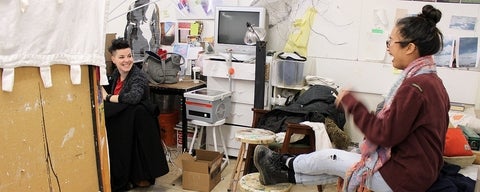
Fourth year students socializing in the studio.
Fabrication labs and studios
The Fine Arts department is located in East Campus Hall (ECH), a retrofitted former warehouse perfect for studio production. The department encompasses about 30,000 square feet of studios, lecture halls, workshops, galleries, and offices.
You can also view a virtual 3D tour of ECH. To view the list of rooms available, click the room name at the bottom corner of the room plan.
Fine Arts houses an impressive array of resources, equipment and tools for students working with digital, analogue and fabrication-based processes. Recent acquisition highlights include a SawStop table saw, an Epilog laser cutter and a professional video kit that includes Canon’s C100 Mark II and a handheld gimbal steady-cam.
Studio spaces, tools and other resources are only available to students enrolled in Fine Arts studio courses that use that particular equipment or space.
Visual Resource Centre
The Visual Resources Centre is located in ECH 1216 and is open daily, Monday to Friday, from 9:00 am until 4:30 pm. It houses our reading room, slide and film collections, and a digital image database. Jean Stevenson, our full-time visual resources curator, oversees this area offering students and faculty individual help with their research.
Life Drawing Sessions
The department regularly offers non-instructional drawing sessions with unclothed models. During the term, sessions normally run Wednesday nights (occasionally on both Mondays and Wednesdays) from 6:30 - 8:30 pm in East Campus Hall. Check the department event listings for more information.
Brush with Art
Brush with Art is a program operated by the Fine Arts Department that hangs student art in public yet secure venues on the University of Waterloo campus.